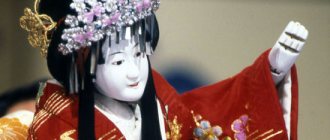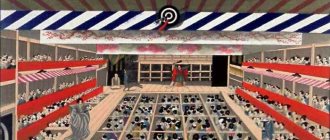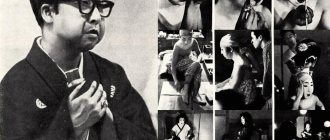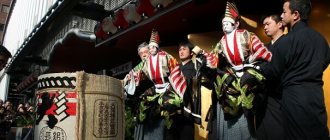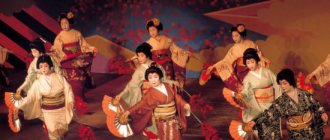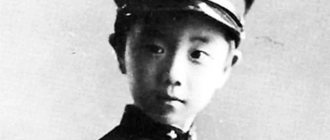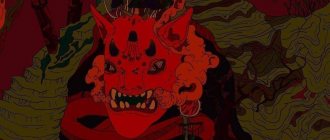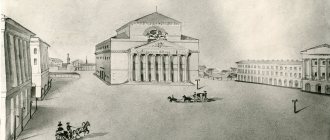“But” (noh) is considered one of the greatest classical traditions of world theater. Its wooden stage, extremely slow and measured acting technique, grandiose costumes, beautiful masks, and minimalist music have been preserved almost exactly as they were used during the Muromachi period (1333-1568).
Noh productions became famous for their deep meaning and otherworldly poetic beauty. They are admired throughout the world and many have been translated into several languages. Noh was popular among the refined court circles in Kyoto, as well as in the upper echelons of the samurai caste. It is therefore not surprising that complex aesthetic theories were created in no, which one of its creators, the actor and playwright Zeami, formulated in his treatises.
In fact, noh plays form only part of an even more complex theatrical tradition called nokagu. It combines serious dramas with lighter kyogen farces. Traditionally, a full daylong performance includes five noh plays, interspersed with four kyogen farces.
History of the Noh Theater
Actor and playwright Kan'ami Kiyotsugu (1333-1384) and his son Zeami (1363-1443) are considered the inventors of noh. The new art form, however, was not created from scratch. Before it gained popularity, there were several other forms of entertainment that were popular at the time, from which the new movement partially borrowed a number of elements.
Early forms of theater include sarugaku plays, which combined dance, music and pantomime. It was a fairly light form of entertainment that may have originated in China. It was sarugaku that became the basis on which Kan'ami and Zeami created their new product - but.
Another traditional genre from which noh was born was dengkaku, a universal genre of entertainment that originated from songs sung during rice planting, as well as ancient rites of fertility and spirit possession. Dengkaku gradually developed into a popular genre that mixed music, singing, dancing and mime.
Noh theater originated in Japan in the 14th century and quickly became popular among the samurai and aristocracy of the Tokugawa shogunate. Initially, it was aimed at the upper class, and was actually inaccessible to the ordinary ignorant population. Today these shows have become much more accessible and can be attended by anyone. However, a casual viewer is unlikely to understand what is happening on stage, since each scene is filled with deep meaning and hidden subtext.
When the shogun's residence was moved to Kyoto, the actor and playwright Kan'ami Kiyotsugu, who is considered the creator of noh, founded his school there, calling it his stage name, Kanjo. After this, he began to improve his performances of sarugaku and dengkaku. Soon Ashikaga Yoshimitsu, the third shogun of the period, became a fan of the noh theater, after which the new movement became very popular among the samurai, many of whom later became patrons of the noh theater.
Zeami, Kan'ami's son, was only 12 years old when he first performed for the shogun. The Shogun took Zeami under his protection and they soon became close friends. Thus, Zeami literally rose from scratch to the highest level of the social hierarchy in Japan. Without any doubt, Zeami is the most outstanding person in the entire history of noh theater. Above all, he was considered the leading actor of his time. In addition, he was a very prolific playwright, as well as a choreographer, musician and director. Zeami also formulated a complex theory of noh theater in his treatises, which will be discussed below. After the death of Shogun Ashikaga Yoshimitsu, Zeami's popularity at court began to gradually decline. In his old age he was exiled to a remote island, where he is believed to have died.
New schools of noh, developing, first cultivated noh in its classical form, developed by Zeami. Noh was later combined with kyogen farce, and the new genre was called nogaku. Remarkable screenwriters enriched the repertoire, and the patronage of the upper class samurai was given to the theater.
During the Edo period (1608-1868), noh theater was still an art form primarily reserved for the samurai class, although gradually more commoners became admirers. Gradually, noh became known outside the circle of noble samurai, as performances in this genre began to be held in temples. The old feudal world collapsed at the beginning of the Meiji period (1868-1912) and Noh lost its original patrons. Due to the dominance of newfangled Western forms of entertainment, they simply stopped being interested. However, thanks to the support of the imperial family, this genre did not completely die.
The continuation of the tradition was ensured in 1881, when the Noh Society was founded, thanks to which the theater became again popular, especially among educated audiences, both in Japan and in the West.
Actors and their roles in Japanese Noh theater
Traditionally, all Noh actors have been men (just recently several Noh actresses have appeared). Basically, the actors are divided into the following categories: - Shite or the main character, who often appears in a mask; - Waki or supporting character who always plays without a mask; — Shite-zure or actors who play the roles of Shite’s comrades; — Waki-zure — actors who play Waki’s companions; - Kokata or minor roles, usually played by boy actors. This system does not mean that the actor specializes in one of the categories listed above. In fact, the actor can appear in any of the above roles (except kokata). In addition, he can also sing in the choir, which is an integral part of the noh production.
Types of games
There are a total of 240 noh plays. They are classified according to their Shite, or main characters, into the following categories:
Divine Performances (Waki Noh)
These plays tell stories about various gods. The Shite actor usually wears a mask and only reveals his identity at the end of the play.
Warrior Performances (Shura Mono) Actor Shite plays the role of a samurai or other warrior whose soul, after his death, cannot find its way to heaven. Only after the prayers of his followers, his karmic deeds are forgiven and the soul finds peace.
Wig Performances (Katsura Mono) In these lyrical performances, actor Shite primarily plays the role of a woman.
Miscellaneous Plays (Zatsu Mono) This group includes miscellaneous plays that do not fit into other categories, such as depictions of ghosts or mad people.
Closed Plays (Kiri No) Actor Shite typically plays the role of a demon in these energetic productions.
The structure of a Noh play usually uses a certain aesthetic principle called Jo-ha-kyu. It traces its roots to old court music originating from India. Zho refers to the beginning or introduction, and its tempo is slow. Ha refers to the middle part of the play, which presents the main dramatic situation. In the kyu, or final part, the tempo of the action and music quickens and the drama reaches its climax.
In the opening sequence of the play, the actors playing the roles of Waki and Shite (often in make-up) appear in turn and formally introduce themselves. Thus, the content of the drama becomes clear. In the middle section the tempo of the dances becomes faster and the drama often culminates in a stylized dance (mai) in which Shite recalls the past. In the finale, Shite returns to the stage as the drama reaches a majestic climax.
The structure of a full Noh performance, which lasted for an entire day, also followed the Jo-ha-kyu principle. The opening of a play is often categorized as a "divine production". In the middle section, such daytime plays are "warrior plays" or "wig plays." And the last part of the play is most often a “closed production”.
Contents of theater plays
Although there are later noh plays, most of them were written during the samurai period, and have a corresponding theme. The main conflict is created between the two opposing ideologies of the period, that is, between pacifist Zen Buddhism and the strict code of ethics of professional samurai warriors.
Very often in the plays there are reflections on karmic issues based on the Buddhist worldview, for example, about how a person must pay for his bad deeds when he becomes a spirit between this world and the other world.
Noh productions may be based on short episodes from classical literature such as Genji Monogatari. Also many of the themes were taken from the great epics of the feudal period.
Japanese plays are full of references to classical poetry, Buddhist scripts, funny stories from history, and even Chinese poetry. One of the characteristic features of productions in the no theater is that their texts show a sharp difference between poetry and prose.
To understand the texts in all their depth, higher education was necessary in feudal Japan. Since the plays were intended for the samurai elite and court circles, polite speech and rules of etiquette were also reflected in the language. For example, in productions but for a simple question “what is your name?” seven words were required according to the rules of politeness. It is therefore not at all surprising that few members of the modern audience can fully understand the texts but also their complex language. That is why most spectators today take special booklets with them to performances, which explain symbolism and literary allusions.
Music and choir
Music in the noh theater has its origins in ancient Japanese musical traditions. The music does not “accompany” the production itself, as is often the case in Western forms of musical theater. However, the music is intended for individual perception by the audience, independent of the play itself, and in fact quite rarely (mostly only in the climactic moments) exactly coincides with the action on stage.
Usually noh productions are accompanied by a small orchestra and choir, which are collectively referred to as hayashi kata. The musicians sit at the back of the stage, facing the audience, while the choir sits to the right of the audience, facing the stage.
The main instruments for musical accompaniment of plays include a flute and three types of drums, the number of which can vary in accordance with the requirements of the play. The flute is used to create long melodic passages, and the drumming emphasizes the climactic moments of the drama. Drummers also use their voices. They scream and howl between strikes. These screams, called kakegoe, play an important role in emphasizing the dramatic action.
It is worth noting that not only the choir sings, but also the actors themselves. Often in productions, the actor sings the beginning of a phrase, which is then completed by the chorus. In Noh songs, which originally came from ancient Buddhist chanting, the singers' voices are very low, regardless of whether the character is male or female. At first glance, vocal technique may seem monotonous. In fact, noh uses five different voice tones: strong, gentle, dynamic, melancholy and sad.
Acting in Japanese theater is very unique. The technique of performance in the theater is characterized by slowness and measured precision of movements. All elements unnecessary for the current dramatic production are eliminated. This gives an almost hypnotic effect.
During performances, the position of the performer’s body must be strictly fixed - with a straight back, and the torso is slightly tilted forward. The fingers should be motionless during gestures. The stylized walking in no is called "hakobi". The soles of the feet rarely rise from the floor. The knees are slightly bent when moving, allowing the actor to literally glide across the stage floor without any visible vertical movement. Slightly bent knees and a straight back allow the actor, in a sense, to “grow” on stage. For example, in a particularly dramatic moment, he may stand up straight to emphasize the situation.
KOZEN HANYUU MASKS AT EXHIBITIONS
“Today the situation in the world is becoming more and more chaotic. And it becomes more important to return to the beginning, which consists of “soul” and “spiritual world” - these words run like a red line through Kozen Hanyuu’s solo exhibitions and joint exhibitions with his daughter Emiko Horimoto. The most significant, reflecting the important stages of Kozen Hanyuu’s creativity, were:
- Personal exhibition in honor of the 50th anniversary of the creative career of the Noh theater mask sculptor at Ginza-Wako in 1983.
- Solo exhibition "To commemorate the publication of the No mask album" at Tokyu Department Store, Shibuya in 1986.
- Exhibition of contemporary Noh and Kyogen theater artists at The Tsubouchi Memorial THEATER of Waseda University in 2008.
- Kozen Hanyuu and Emiko Horimoto's "Father and Daughter" exhibition at Odakyu Department Store, Shinjuku in 2011.
- Anniversary exhibition of Kozen Hanyuu and Emiko Horimoto in honor of the double centenary - 100th anniversary of father, Kozen Hanyuu, a Noh mask sculptor, and daughter, Emiko Horimoto's 100th exhibition, at Art Salon, Odakyu Department Store, Shinjuku, in February 2021.
Japanese Noh theater masks
Noh's extremely measured and minimalistic acting technique was partly due to the strict court etiquette of the period when Noh theater was at its peak. According to the rules of etiquette, facial expressions were regarded as vulgarity. Therefore, the actors who did not wear masks tried to keep their faces completely impassive. However, even such measured movements could convey emotions with the help of masks. By slightly changing the tilt of his head, the actor was able to change the facial expression on the mask. By adjusting the tilt of the mask in this way, her expression changed from joy to sadness.
Noh theater masks were developed from earlier Japanese mask systems. Compared to wooden gigaku masks, for example, noh masks are smaller in size as they only cover the central part of the actors' faces. Old masks are now considered real works of art. They were preserved and used by entire generations of families, as well as schools.
Masks are worn by some of the shite characters, as well as some of their shite-zure companions. Most masks depict generally accepted characters, such as a young woman, an old woman, a middle-aged samurai, a young aristocrat, etc. However, some of the masks are only used for specific roles.
Noh theater costumes
The magnificent costumes of Noh theater come from the court circles of the Muromachi period. It is believed that in the earliest stages the costumes were much simpler. Just like masks, elaborate robes in but appeared later, with the development of this genre.
The costumes (shozoku) are full of symbolism, so viewers are often forced to pick up explanatory booklets, which often include explanations of the meanings of the costumes and their ornamented details. There are some specific forms of costumes characteristic of noh. These include, among other things, very wide trousers on some of the male characters and ornate, colorful clothing on many of the female characters. The actor, in a wig and a complex costume, looks almost like a living sculpture. Thus, perfect order in attire and hairstyle is of paramount importance. That is why in noh there is such a thing as actor’s assistants, who periodically go on stage to adjust the performers’ wigs and costumes.
Five schools
But it is still carried out today and is divided mainly into five “schools” or acting movements, which were founded over the centuries by famous actors. Such schools include Kanze, Hosho, Konparu, Kongo and Kita. The most prestigious of them is the Kanze school, which was founded by Kan'ami Kiyotsugu, the creator of the entire genre. As a rule, all professional performers belong to one of five schools. This profession is largely hereditary. Typically the performer joins the same school as his father and then trains his successor.
Source 4dancing.ru
KOZEN HANYU – THE OLDEST MASK SCULPTOR OF THE NO THEATER
Kozen Hanyuu , the oldest Noh mask sculptor, continued the path of his father Mitsunaga Hanyuu , who belonged to the Mitsui family. Kozen Hanyuu, the third son in the family, was born in 1917 in Asakusa, Tokyo. In 1932, he began working with Noh masks, to which he devoted more than 80 years and was a member of the Japan Sculptors Association and the Japanese Noh Institute. His daughter, Emiko Horimoto, once said that it is extremely rare for three generations of one family to devote their art to the search for the spiritual world, to conduct a “dialogue with the spirit.” The artist’s grandfather and father are the creators of Noh masks – inhabitants of the other world, and her daughter depicts in her paintings “the world of the heart and soul.”
Japanese theater - classics from antiquity to the present day
One of the classic theaters of Japan is kabuki. This is a surprisingly organic combination of dramatic, dance and musical acts. The unique combination of shape, sound and color gives magnificent associations between what is happening on stage and real life.
Japanese theater began
comes from the creator Izumo no Okuni, who was a shrine maiden who originally performed with a female troupe in the dry bed of the Kamogawa River near Kyoto. The name kabuki came later, and it meant the technique of dancing and singing. Later, in 1629, onna kabuki (female troupes) were banned, since the performances were mostly erotic scenes and dances, which often led to conflicts between spectators. In addition, very often actresses engaged in prostitution, which displeased the shogunate.
However, wakashu kabuki involving young men, who were also a huge success because they engaged in almost the same frivolous behavior, also led to dissatisfaction with the authorities, and in 1652 a ban was introduced until a complete reformation. After this, all roles in the theater began to be played by adult men, erotic scenes were removed and kegen farces from the Noo Theater were introduced. These innovations led to the fact that instead of variety shows, kabuki became drama theater. After a few decades, farces gave way to fairly serious plays that were written specifically for this type of theater.
The design of the halls for kabuki performances has also changed. Now a special platform extended from the stage into the middle of the auditorium, on which actors could appear. Also one of the innovations was a curtain, which allows you to change the scenery unnoticed.
The basis of all the plays that have been staged and performed so far is the Buddhist teaching, in which the villain must be defeated, the long-suffering woman is rewarded with happiness, and powerful military leaders or overly arrogant families must be overthrown. There are quite a lot of Confucian traditions that talk about duties, duty, and filial piety, which sometimes lead to various situations that end in drama.
The main forms (kata) that are used and distinguish Kabuki theater from others are stylized fights - tate, leaving the stage with emphasized gestures - roppo, silent scenes - dammari, which cannot be changed at the whim of the actor. Basically, this always applies to plays in which the military class is present, and the acting often goes beyond the realm of realism.
In addition, each genre includes specific costumes, makeup, and wigs, which are carefully selected in terms of style, design, and elegance. If these are samurai - an aristocracy, then they have a special stylization; if this is a different status, then the makeup, costumes, and style will be different.
Japanese theater - puppets for adults
Another most famous Japanese theater
– bunraku. It is a puppet show, with shamisen accompaniment and a song tale. One of the first plays, “Suicide of Lovers on the Island of Heavenly Nets,” was so realistic that after its performance, suicides followed throughout the country, and therefore it was banned. Another, no less famous, “Treasury of Samurai Loyalty” formed the basis for a large number of films based on its plot.
The name of this theater was given in honor of its founder, Uemura Bunrakuken. Osaka became the owner of the largest bunraku puppet theater in 1872.
The dolls that take part in the performance are assembled on a wooden frame with a large number of threads with which they are controlled. The height of each doll is about 150 centimeters. Moreover, almost none of them have legs. Only in rare cases do male dolls have legs attached. Each doll is controlled by three actors: omozukai - the main master puppeteer, responsible for the head and right hand, hidari-zukai - for the left hand, and ashi-zukai, working with the legs. The art of controlling such a doll is very difficult, since it must clearly imitate all the movements of a real person.
The most difficult thing is working together. Previously, the process of training a beginner as a master took about 10 years, now puppeteers complete a 2-year course, receive the name of a professional performer, and only after that they begin to work with the masters and go through a certain school with them.
During the performance, all puppeteers wear black clothes with a hood so as not to interfere with the action on stage, and only the most eminent masters have the right to go on stage in white clothes. The performance begins with the narration of the singer-storyteller Gidayu, invisible to the audience, and the roar of drums accompanied by shamisen.

